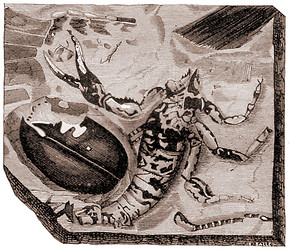Scorpionida
Scorpions and their extinct relatives
Scott A. Stockwell


This tree diagram shows the relationships between several groups of organisms.
The root of the current tree connects the organisms featured in this tree to their containing group and the rest of the Tree of Life. The basal branching point in the tree represents the ancestor of the other groups in the tree. This ancestor diversified over time into several descendent subgroups, which are represented as internal nodes and terminal taxa to the right.

You can click on the root to travel down the Tree of Life all the way to the root of all Life, and you can click on the names of descendent subgroups to travel up the Tree of Life all the way to individual species.
For more information on ToL tree formatting, please see Interpreting the Tree or Classification. To learn more about phylogenetic trees, please visit our Phylogenetic Biology pages.
close boxIntroduction
Scorpions are easily distinguished from other arachnids by their large, well developed claws (pedipalps) and distinct division of the abdomen (opisthosoma) into a broad preabdomen (mesosoma) and narrow, tail-like postabdomen (metasoma). All scorpions possess a poisonous sting (telson) and a pair of peculiar, comb-like, sensory appendages called pectens.
There about 1100 species of scorpions known worldwide, and probably that many more still to be discovered. Although they are normally associated with hot, dry areas like deserts, scorpions are found in a variety of habitats including cool, wet forests and grasslands.
Scorpions are among the oldest arachnids. The earliest fossils date from the middle Silurian rocks, over 400 million years old. Early scorpions had large compound eyes, but were otherwise similar to living forms.
Scorpions are generally large arachnids. Adults range in size from 1.5 cm to 21 cm in length. Some fossil scorpions are thought to have been up to 1 meter in length! All are predatory. Their prey includes a variety of arthropods and other invertebrates, and the larger species are known to prey on small vertebrates.
The scorpion's most notorious feature is its poisonous sting. While all scorpions are venomous, only about twenty species worldwide possess venom of sufficient toxicity to kill humans.
Discussion of Phylogenetic Relationships
The phylogeny of the Scorpionida is highly controversial. The phylogenies shown here and on subsequent pages are based on my dissertation work (Stockwell 1989). They are provisional, though the corresponding classification has already been adopted by some fossil workers (Selden 1993, Jeram 1994). The placement of the Scorpionida is disputed among workers. The most recent phylogeny (Shultz 1990) places the Scorpionida as the sister group of the Pseudoscorpiones + Solifugae, but other workers, including myself, consider the recent scorpions (Scorpiones) to be the sister group of all other arachnids, or an altogether separate eurypterid clade. Unfortunately, this will remain difficult to test due to the lack of resolution in the otherwise obviously paraphyletic Eurypterida.
In an effort to rectify the fossil and recent classifications of scorpions, which were hitherto incompatible (Kjellesvig-Waering, 1986), I proposed to raise the Scorpionida to the rank of class with three orders, Protoscorpiones, Palaeoscorpiones, and Scorpiones (Stockwell 1989). The strictly phenetic suborders and infraorders of Kjellesvig-Waering (1986) were largely abandoned.
The fossil group, Protoscorpiones, is not demonstrably monophyletic, but is included for the sake of completeness and clarity. They possess the most plesiomorphic, euypterid-like legs and sternocoxal arrangements, as well as well-develpoed lateral compound eyes. It is possible that these early scorpions are the actual ancestors of other groups. Geological range: middle Silurian to lower Devonian.
The fossil group, Palaeoscorpiones, possesses an enlarged prosomal sternum that completely separates the midcoxae. Their legs are cylindrical, like those of eurypterids and protoscorpions, but the tarsi are showing plantigrade features that could be considered land adaptations. Could the Palaeoscorpiones share a most recent common ancestor with the non-scorpion arachnids? Geological range: upper Silurian to middle Carboniferous.
The group Scorpiones encompasses most known scorpions, both fossil and Recent. All show development of an increasingly sophisticated preoral chamber comprised of the first and second leg coxae. The reduction of compound eyes and loss of one pair (and in some extinct groups, two pair) of pulmonary books (and the corresponding fusion of opisthosomal sternites), so characteristic of modern scorpions, occurs in this group. Scorpiones contains a great many fossil specimens that I consider incertae sedis. Some might one day be classified, but most lack critical characters that could be used to ally them with any group more inclusive than the Scorpiones. Geological range: lower Devonian to Recent.
References
Jeram, A.J. 1994. Scorpions from the Viséan of East Kirkton, West Lothian, Scotland, with revision of the infraorder Mesoscorpionina. Tranactions of the Royal Society of Edinburgh: Earth Sciences, 84:283-299.
Kjellesvig-Waering, E.N. 1986. A restudy of the fossil Scorpionida of the world. Organised for publication by A. S. and K. E. Caster. Palaeontographica Americana, No. 55, 287 pp.
Schulz, J.W. 1990. Evolutionary morphology and phylogeny of Arachnida. Cladistics, 6:1-38.
Selden, P.A. 1993. Arthropoda (Aglaspidida, Pycnogonida, and Chelicerata), pp. 297-320. In: The Fossil Record 2 (M. J. Benton, ed.). Chapman and Hall, London.
Stockwell, S.A. 1989. Revision of the Phylogeny and Higher Classification of Scorpions (Chelicerata). Ph.D. Dissertation, University of California, Berkeley. 413 pp.
About This Page
Scott A. Stockwell

Walter Reed Biosystematics Unit Museum Support Center, Smithsonian Institution Washington, D. C., USA
Page copyright © 1996 Scott A. Stockwell
All Rights Reserved.
Citing this page:
Stockwell, Scott A. 1996. Scorpionida. Scorpions and their extinct relatives. Version 01 January 1996 (under construction). http://tolweb.org/Scorpionida/2558/1996.01.01 in The Tree of Life Web Project, http://tolweb.org/








 Go to quick links
Go to quick search
Go to navigation for this section of the ToL site
Go to detailed links for the ToL site
Go to quick links
Go to quick search
Go to navigation for this section of the ToL site
Go to detailed links for the ToL site